Menomonee Falls, Wis. — As a new school year begins, a survey of 9th to 12th graders reveals that unclean school restrooms cause them to have a negative perception of their institution and its leaders. 68% of students say school restrooms that are poorly maintained or unclean show the school doesn’t care about its students Read more
Bradley Handwashing Survey
Menomonee Falls, Wis. — As a new school year begins, a survey of 9th to 12th graders reveals that unclean school restrooms cause them to have a negative perception of their institution and its leaders. 68% of students say school restrooms that are poorly maintained or unclean show the school doesn’t care about its students, reflects poor school management and lowers their overall opinion of the school. In fact, nearly half of students describe the condition of their school restrooms as poor or fair.
The findings are part of the Healthy Hand Washing Survey conducted by Bradley Corporation. The research asked students across the country about their school restrooms and hand washing habits.
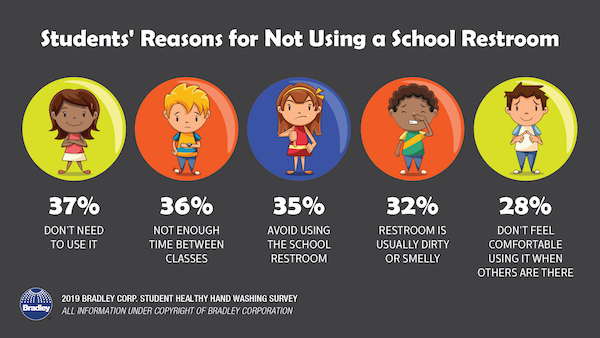
“The negative impact of poorly maintained school restrooms is clearly significant and spreads beyond the bathroom doors to the entire school,” says Jon Dommisse, director of strategy and corporate development for Bradley Corp. “Female students are even more inclined to be negatively influenced by run-down school restrooms.”
The state of a school restroom likely factors into a student’s decision on whether or not to visit the restroom. While most (81%) use their school restroom on a daily basis, 19% claim to never frequent it. They avoid the facilities in part because they’re dirty, smelly or have broken or old toilets, sinks and doors.
Outside of schools, restroom conditions in public businesses also influence high school students’ perceptions and preferences. Most students (62%) have frequented a particular business based on its cleaner, well-maintained restrooms. Similarly, 64% of adults show preferential treatment for businesses with pleasant restrooms.
Privacy Tops Student Wish List
Students do have suggestions for school restroom improvements. Their number one request is more privacy. They’d like taller stall doors and want gaps between the stall panels eliminated. Their second wish is for cleaner facilities followed by more air fresheners. When asked what bothers them the most about school restrooms, foul odors top the list.
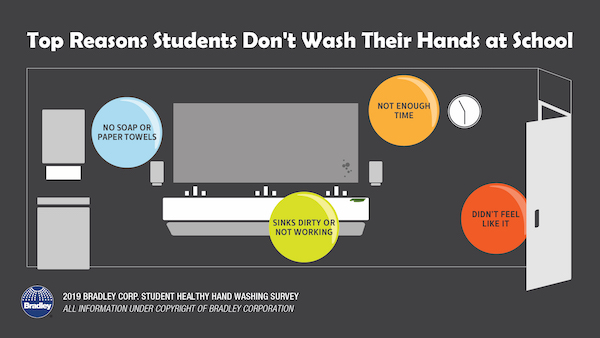
If students do encounter an unclean or unpleasant restroom, they usually skip their trip. More than half say they leave without using the restroom and 39% try to avoid using that restroom in the future. Just 20% take action to address the situation by notifying a teacher or school management.
In contrast, the Healthy Hand Washing Survey found that when adults are faced with an unpleasant restroom, their first course of action is to alert management (43%). Just 26% of adults choose to exit without using the facilities as opposed to the 52% of students who do so.
Avoiding Germs in School Restrooms
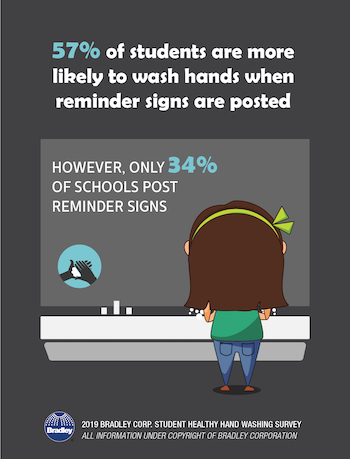 Germs in school restrooms are another hot topic. Students believe the germiest surfaces are toilet flushers, the floor around the toilet and stall door handles. Students back up their beliefs with actions – 46% operate the toilet flusher with their foot in order reduce their contact with germs and 33% use a paper towel to open the door. Females are significantly more likely to use these germ-avoidance strategies in restrooms.
Germs in school restrooms are another hot topic. Students believe the germiest surfaces are toilet flushers, the floor around the toilet and stall door handles. Students back up their beliefs with actions – 46% operate the toilet flusher with their foot in order reduce their contact with germs and 33% use a paper towel to open the door. Females are significantly more likely to use these germ-avoidance strategies in restrooms.
And, even though most schools don’t post hand washing reminders, they might consider it. 57% of students say they’d be more likely to wash if there was a sign in the restroom.
The Healthy Hand Washing Survey by Bradley Corp. was conducted online Jan. 3-8, 2019 and queried 630 American students enrolled in 9th – 12th grade. Participants were from around the country and were fairly evenly split between males and females (49 and 51%).
Bradley is a leading manufacturer of commercial plumbing fixtures, washroom accessories, restroom partitions, emergency fixtures and solid plastic lockers.
For more information, visit www.bradleycorp.com/handwashing.
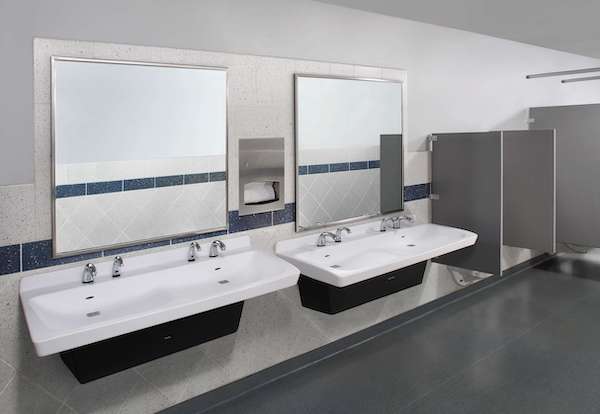
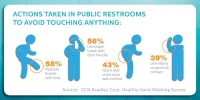
Americans Encountering More Unkempt Restrooms, Triggering Negative Perceptions of Businesses Milwaukee, Wis. — The “ick factor” in public restrooms appears to be growing, according to a survey that tracks Americans’ attitudes toward restroom facilities. Almost 70% report they’ve had a particularly unpleasant experience in a public restroom due to the condition of the facilities—a nearly Read more
Americans Encountering More Unkempt Restrooms, Triggering Negative Perceptions of Businesses
Milwaukee, Wis. — The “ick factor” in public restrooms appears to be growing, according to a survey that tracks Americans’ attitudes toward restroom facilities. Almost 70% report they’ve had a particularly unpleasant experience in a public restroom due to the condition of the facilities—a nearly 20% increase since 2012.
![Bathroom Aggravations_rev0116 copy[1]](https://mechanical-hub.com/sites/plumbing/wp-content/uploads/sites/3/2016/02/Bathroom-Aggravations_rev0116-copy1.jpg) That’s bad news for businesses since Americans say they judge establishments based on the state of their restrooms. According to the 2016 Healthy Hand Washing Survey conducted by Bradley Corporation, most consumers believe a bad restroom indicates poor management, lowers their opinion of the company, shows the business doesn’t care about customers, and makes them think the company is lazy or sloppy.
That’s bad news for businesses since Americans say they judge establishments based on the state of their restrooms. According to the 2016 Healthy Hand Washing Survey conducted by Bradley Corporation, most consumers believe a bad restroom indicates poor management, lowers their opinion of the company, shows the business doesn’t care about customers, and makes them think the company is lazy or sloppy.
“The vast majority—91%—told us that a business with high quality products or services should have high quality restrooms,” says Jon Dommisse, director of global marketing and strategic development at Bradley Corp. “Likewise, in the workplace, 88 percent of workers think the condition of restrooms is one indicator of how a company values its workforce. Yet, only half rate their workplace restrooms as excellent or very good compared to 62% one year ago.
![Avoiding Germs Infographic_0116 copy[2]](https://mechanical-hub.com/sites/plumbing/wp-content/uploads/sites/3/2016/02/Avoiding-Germs-Infographic_0116-copy2.jpg)
Bradley, a manufacturer of commercial plumbing fixtures, washroom accessories, restroom partitions, emergency fixtures and solid plastic lockers for 95 years, also delved into what factors makes restrooms so unappealing. Chief restroom grievances include toilets that are clogged or not flushed; a really bad smell; an overall appearance that’s dirty, unkempt or old; and partition doors that don’t latch closed.
Key restroom improvements Americans would most like to see include improved cleanliness, a completely touchless experience, better stocking of restroom supplies, and a never-ending supply of paper towels—even if there are dryers.
As for restroom improvements they’ve seen over the past two to three years in specific types of facilities, respondents gave the highest marks to medical buildings, airports, restaurants and higher education facilities. At the other end of the spectrum, restrooms in convenience stores, gas stations and truck stops deteriorated the most.

Americans make no secret about their disdain for coming into contact with germs in public restrooms. Restroom entrance door handles, stall handles and faucet handles are the surfaces that make them the most squeamish. Almost 60% of respondents say they operate the toilet flusher with their foot to avoid germs. More than half use a paper towel to cover the door handle while others use their butt to open and close doors.
When it comes to concerns about other people not washing their hands, restaurants and health care facilities are the two types of establishments that give Americans the most anxiety.
“It pays off for businesses to provide clean, stocked, easy to use washroom facilities with touch-free fixtures to ensure the user has a positive experience,” Dommisse said. “In our eighth year of doing this national survey, it remains clear that the condition and cleanliness of the public restroom are always in the spotlight, and affect customer, employee and stakeholder perceptions.”
The Healthy Hand Washing Survey queried 1,062 American adults online Dec. 10-13, 2015 about their hand washing habits in public restrooms and concerns about germs, colds and the flu. Participants were from around the country, were 18 years and older, and were fairly evenly split between men and women (47 and 53%).
